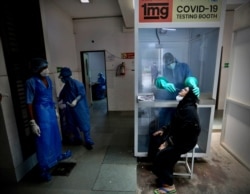After rushing to take care of her parents when they were infected with COVID 19 last month, Suhasini Sood began making frantic calls to hospitals. Her parents are more than 70 years old.
“You had read in the news that people had gone to hospitals and hospitals had refused patients and that they had said no beds were available. So that was a big fear,” recalls Sood, who lives in the Indian capital, New Delhi — home to more than 20 million people.
While some hospitals refused, others said they would only take a call when she took them in. “No one committed that if he is seriously ill, we will give him a bed.”
To plug the huge shortfall of hospital beds that emerged as the pandemic raged, cities like Delhi have raced to set up huge temporary centers — a 10,000-facility fitted with cardboard beds and operated by the paramilitary recently opened on the premises of a religious center.
Train coaches and even marriage halls have also been converted into COVID care centers in Delhi. In the financial hub of Mumbai, new field hospitals that opened this week include one on a horse racing track. The city has already set up temporary health care facilities in a stadium and a planetarium.
New Delhi and Mumbai are India’s worst affected cities.
The rush to open temporary centers and build up health infrastructure was inevitable — the number of coronavirus cases is reaching near the one million mark.
That is because the country’s abysmally low spending on public health has left its health infrastructure falling hugely short, say experts.
“About 2.5 beds per 1000 population has been generally the international norm, whereas in India it has been less than one bed per 1000 population,” according to Srinath Reddy, president of the Public Health Foundation of India. And though the biggest cities account for most of these beds, even they ran short, he points out.
While India’s stringent lockdown initially kept the coronavirus count low, the situation changed dramatically in June as the virus began rampaging through densely packed cities after they opened for business. There have been numerous reports of patients running from one hospital to another after being turned away.
With health care facilities overwhelmed, some cities like the information technology hub of Bengaluru have ordered new lockdowns.
But in Delhi doctors say there is a ray of hope — the scramble for beds and shortages of medical personnel that emerged as doctors and nurses fell sick have eased.
“The number of people who are turning out to be new corona cases is on the rise but at the same time the number of people requiring critical care, ICU care, ventilatory care is on the decline and most of the COVID care hospitals have vacant beds for such patients,” says Arvind Kumar, head of the Center for Chest Surgery at Sir Ganga Ram Hospital, one of Delhi’s largest hospitals.
That is not just because temporary facilities have been added. Public health experts point out that more than three months after cases began rising in India, doctors also have a better handle on how to treat the virus.
“It is only later on that reassurance came that only 15 per cent or so may require hospitalization and only five per cent may require intensive care and only two to three per cent may be actually critical,” says Reddy. “The rest could be treated at home.”
Sood’s 70-year-old mother and 75-year-old father, for example, had many anxious moments as their fever dragged on for over two weeks, but they finally recovered at home.
Such cases have made doctors hopeful that even as numbers continue to rise, the mortality rate can be held down.
However, the pandemic also highlighted the glaring gap in facilities between India’s expensive private hospitals and public ones — middle and upper class Indians like Sood ruled out being treated at a government center.
“That was never an option,” says Sood emphatically, who at one point thought her father would need hospital care. “I think the perception of a public hospital is that basic hygiene standards might not be met and fear that he will be uncomfortable and contract other illnesses so, yeah, that was never something we considered.”
Whether India overhauls its public health facilities remains to be seen. But even as the world’s third worst affected country faces a long and hard battle to control the pandemic, doctors say some lessons must be learned.
“Should such a virus strike again, the healthcare infrastructure has to be prepared and resilient to absorb that shock and respond to that challenge in a more routine way, rather than the emergency way in which we have responded,” says Kumar.











